JOHN GLEN
BY JEFFREY RESSNER
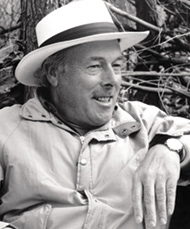
Starting with 1963’s From Russia with Love, James Bond films have become distinctive for their pre-credit sequences, those thrilling “mini-movies” before the opening titles that give audiences a taste of the action and mayhem to come. Ranking among the most memorable moments of the entire Bond canon is the opening of Octopussy (1983). It was the sixth entry starring Roger Moore as the suave British superspy and the second 007 film directed by John Glen, who had previously served as an editor and second unit director on three other movies in the series.
The sequence depicts Bond escaping from a brutal South American dictatorship with the aid of the world’s smallest jet, a single-seat BD-5J called a “Bede.” The flying scenes are thrilling enough on their own, but there’s also a sense of impending danger. Bond’s jet is pursued by a missile through the skies until he evades the rocket by zooming through the open doors of an aircraft hangar and emerges on the other side. To do this, the microjet turns side-ways in order to slip through the hangar’s rapidly closing doors.
And if that’s not enough, the plane runs out of fuel shortly thereafter.
Glen got the idea for the sequence when his Moonraker pilot, J.W. “Corkey” Fornof, who showed him a commercial he had recently made in Japan featuring a Bede flying through an empty hangar at 250 mph. “It was the most boring thing I’d ever seen and it wasn’t very effective,” recalls Glen. The Japanese ad had no actors, no sense of pursuit, not the slightest bit of drama. But the director turned it into one of the most fabulous Bond stunts ever filmed.
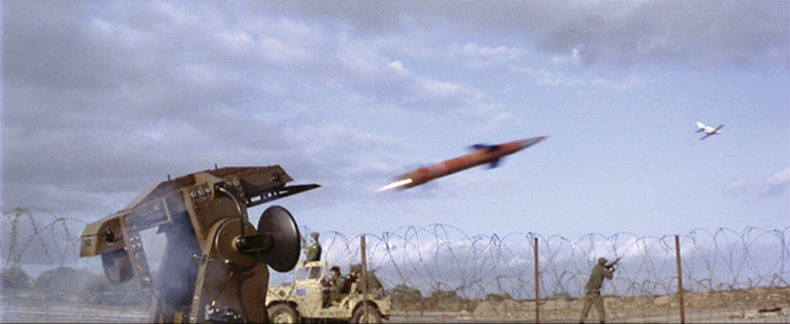
This was an actual rocket that we used to fire at Bond's Bede jet. It was simply a fireworks pyrotechnic effect, but it worked very well. We had made three mock-ups of the Bede for Moonraker, but didn’t use them. For Octopussy we used all three models, one that actually flew, and a Hawker Siddeley 127, which was about four times as big as the Bede but doubled for it quite effectively in long shots. We used the 127 for the long approach shots, and would then cut to the close-ups of Roger in the cockpit, then cut to the model going into the hangar as the doors began closing.
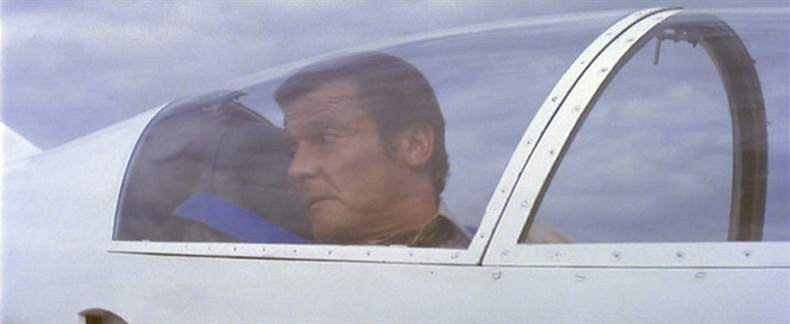
We shot Roger in the Bede jet at Pine-wood with a sky backing and smoke blowing through a wind machine, with the camera on tracks zooming in and out to make it more realistic. We didn't have computer effects, so everything was smoke and mirrors. We frequently used these moving backings, which were very much lo-tech. Green screen was in its infancy, and it wasn't until several years later when it was used with computers that it came into its own. The old photographic system of using a green screen, taking the green out and using a matte was never satisfactory because there'd be too much loss of generation. So we tried to avoid it whenever we could.
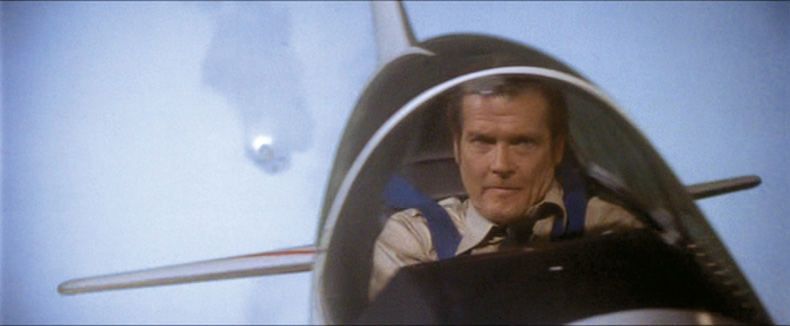
The missile launched to destroy Bond's Bede jet was another challenge. I suggested jokingly to special effects supervisor John Richardson that he just use a model for the jet and tie a flaming firework behind it. He laughed at first, stopped to think and then gave it a try. It worked beautifully in the end; wherever the plane went, the rocket followed. We shot it at 72 frames per second against a clear sky, which is rare in London, and that's how we achieved this shot. Here we used a front projection system, and John shot some short pieces of the rocket without the plane and got enough for us to use, which were each about three seconds long.
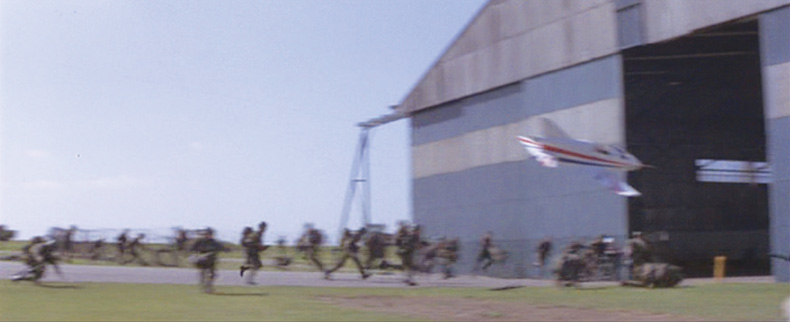
We had a model of the Bede sent down on wires, and our special effects supervisor was able to arrange the wires to cleverly change the angle of the plane's approach. Then we built a foreground miniature of the hangar door, placed directly in line with the existing door, and photographed it so it matched exactly. It was actually a tough photographic job to merge it with the actual hangar, and we were only able to do this because film is two-dimensional. So the overall shot really gave the impression that Bond was flying through this ever-diminishing gap, and the only way he could get into the hangar was to tilt the aircraft until he was almost flying horizontal.
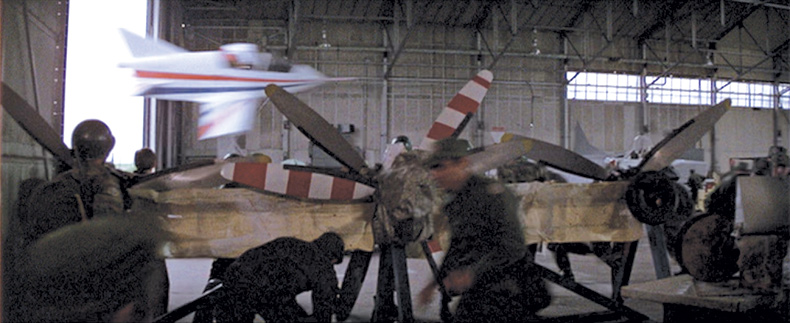
Corkey Fornof, our Bede pilot, refused to fly through the aircraft hangar while other people were inside because of the potential for disaster. So our special effects supervisor bought an old Jaguar XJ6, stripped the car down to its chassis, mounted a hydraulic rig called a pole arm to it, and attached a full-sized Bede jet mock-up to the top. The rig gave the driver terrific control, and he could use the hydraulics to alter the pitch of the aircraft's wings as it made its way through the hangar. We put Roger in the cockpit, and had soldiers scurrying in the foreground to cover up the pole arm so that it wasn't visible in the finished shot.
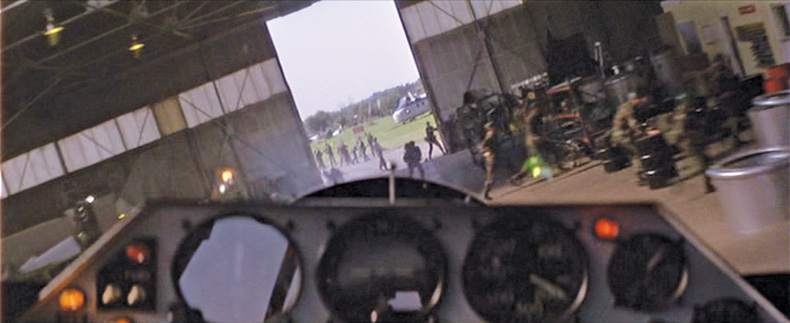
We used a camera mounted inside the mock-up—atop the pole arm with the Jaguar driving underneath it—to show the closing doors at the other end of the hangar from 007's point of view. The Jaguar was moving at 55 mph and we shot the sequence at around 20 frames per second, which helped speed it up a little bit. The whole effect inside the hangar probably took two days to shoot, quite a lengthy period and something the first unit couldn't afford to sit on. So we put it out to the second unit, but it had to be completely organized and orchestrated, and everything was elaborately sketched out on storyboards that matched the action shot for shot.
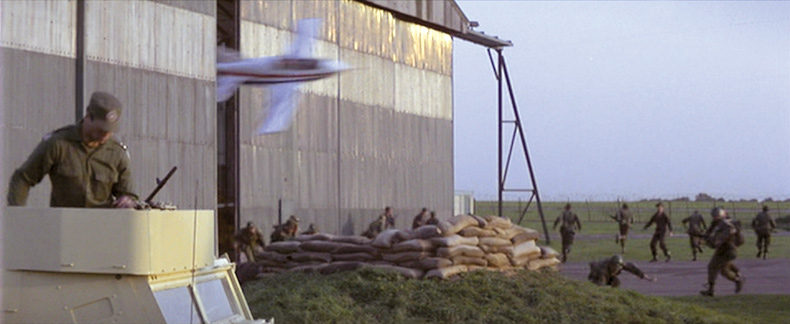
Again, the plane is on wires and we're using a foreground miniature, only it's on the other side of the hangar. We probably even used the same mock-up door. We scaled the miniature exactly so that when it was in position, it fooled you completely and you thought you were looking at the whole structure. That door on the left is just beyond the soldier, while the rest of the hangar is about 50 yards away. What really gives the shot life is that soldier in the foreground. We used the wire-rig to make the plane tilt on its wingtips to go through the decreasing gap in the door. We had several goes at the shot, and this seemed to be the tightest one we could manage.
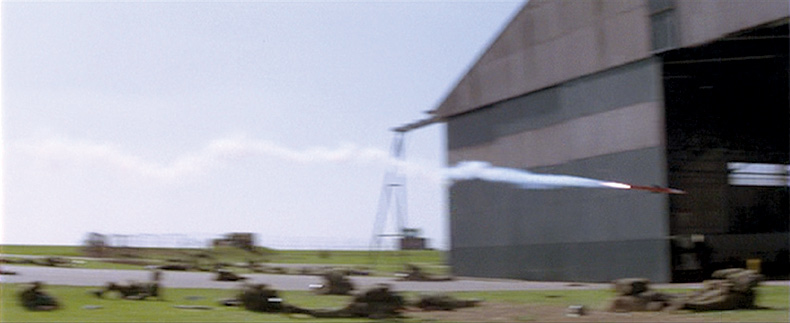
For the missile going into the hangar, we again used a dummy rocket, only this time it was attached to a wire and was sent down by the special effects supervisor. We had all the soldiers ducking and diving to create a lot of action on the ground and bring it alive. In the first Bond film I directed, For Your Eyes Only, we had a similar scene with a piloted helicopter going in to a shed. In Octopussy we used the same kind of technology, but we improved on the idea a great deal. The art department and everyone involved did a great job, a great team effort.
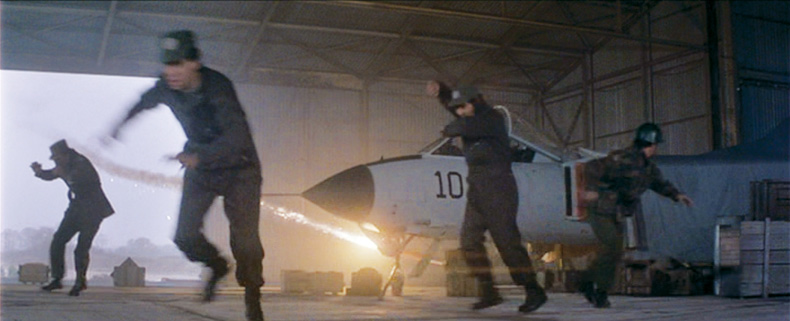
We used a mock-up of a full-sized plane here, and then covered up the back part with a tarp as though the aircraft was under cover. We brought the rocket in on a wire screaming in with all the soldiers in the foreground running away and trying to save their skin, followed by the explosion. Richardson was known for his big bangs, and indeed he was the master of the controlled explosion. Nowadays everything would be computerized, even the explosions. Computer imaging is used to enhance the blast and fireballs, but somehow they never seem as real as when we did them.
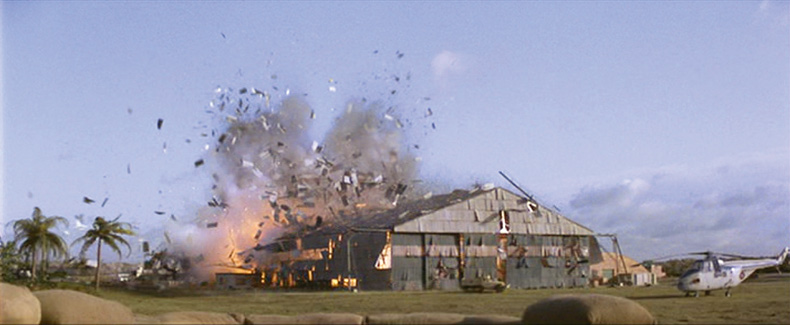
We built a fairly large model of the hangar, about 6 feet by 10 feet, and staged a series of small explosions that grew larger with each blast. We showed the explosion from 007's point of view as he flew away on the Bede jet. With all of these types of pyrotechnics you stand a better chance of showing the blast's power if it's a moving shot more than a static shot. There weren't any people in the foreground, so we could get away with filming it at fast speed—around 72-100 frames per second. This would slow the explosion down to get a more dramatic effect.
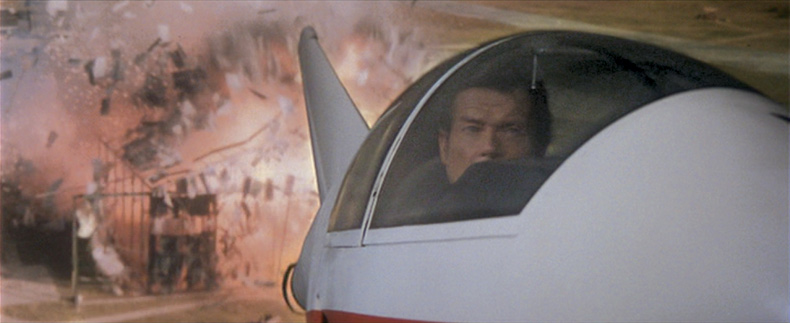
This is Bond in the Bede jet as the hangar explodes behind him. The actual hangar was at an aerodrome in Northolt we had used in the Bond films going back to Thunderball. But Roger is in the mock-up at Pinewood Studios while the blast was shown behind him on a screen with front projection. We knew we were only dealing with a shot that lasted a couple of seconds, and you get away with a lot—you move the camera, you give it a shake, anything to get the realism of an explosion.
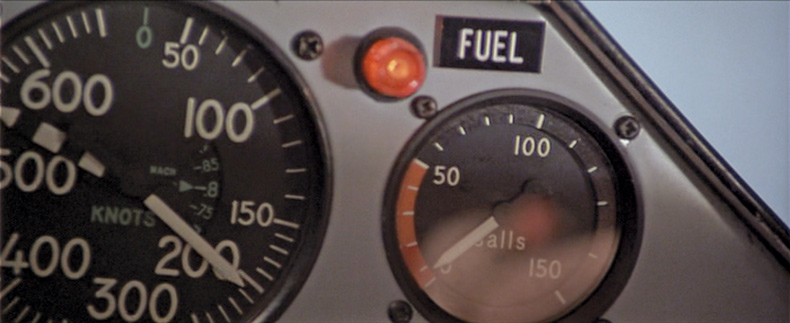
This insert shot was typical of the humor we'd put into the Bond films. If you were in a motorcar and running low on fuel, you might tap the fuel gauge hoping you have a bit more gas in it. We almost did the same thing here; [you'd] see Roger's finger come in from off screen and tap the dashboard, hoping to stop the red light from flashing on. It's ridiculous, really, but it's funny and makes people laugh.
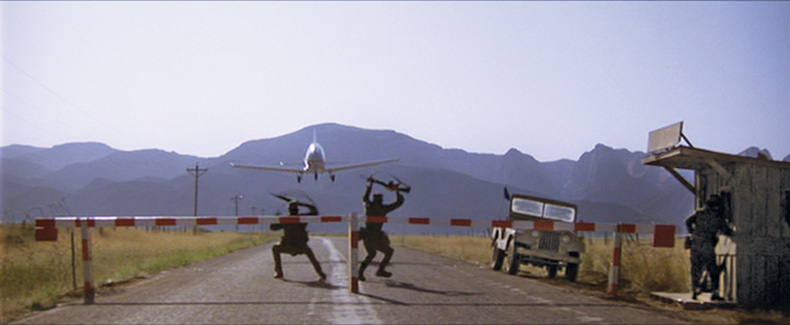
This shot was actually done quite a bit earlier in Monument Valley when a second unit crew went to America to shoot some aerial shots with the Bede jet. That's Corkey in the Bede flying low over the two officers at the border crossing, and Phil Wrestler did the directing on this part. We actually did a lot of shooting there, including a scene where a plane crashes into a mountain and some other great stuff where the plane soars into the sky and dips under bridges at fast speeds.
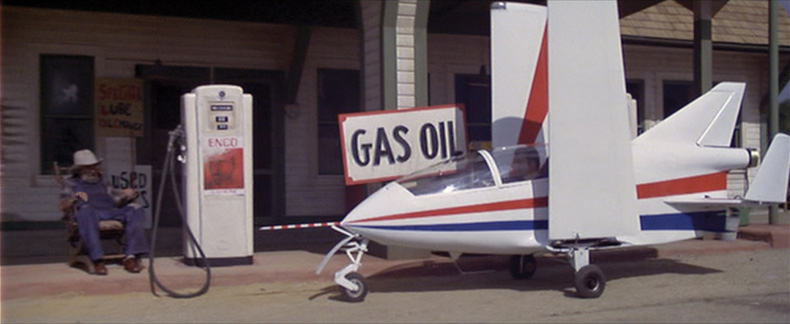
When the Bede jet runs out of gas, it lands and pulls up to the petrol station where Bond sees this old attendant sitting there and says, 'Fill 'er up.' At one point I had cut that little end tag, but I was with my family near Brighton soon afterward and we ducked into a cinema to escape the rain. Lo and behold, there was a trailer for Octopussy, and it featured that very shot. The ‘Fill 'er up' line got a huge laugh. I went back to the editing room Monday morning and immediately put it back in the film. If you excite audiences with a really good action scene, you can have the weakest joke at the end and it'll get a good laugh. It's tension release.